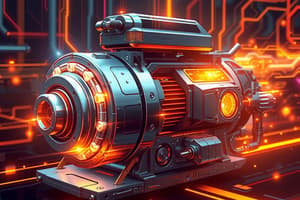Podcast
Questions and Answers
What is the purpose of the electronic commutation system in a BLDC motor?
What is the purpose of the electronic commutation system in a BLDC motor?
The electronic commutation system in a BLDC motor replaces the mechanical commutator found in brushed motors with an electronic switch circuit. It includes controllers and sensors like Hall effect sensors or rotary encoders to determine the rotor's position and control the stator windings accordingly.
What is the construction of a BLDC motor?
What is the construction of a BLDC motor?
The rotor of a BLDC motor is composed of permanent magnets, while the stator contains the current-carrying conductors or armature windings. Additionally, BLDC motors utilize an electronic commutation system and can be designed as Outrunner or Inrunner.
What components are used for electrical commutation in a BLDC motor?
What components are used for electrical commutation in a BLDC motor?
The current-carrying conductors or armature windings in the stator are used for electrical commutation in a BLDC motor, converting electrical energy into mechanical motion.
What are the design variants of BLDC motors?
What are the design variants of BLDC motors?
How do BLDC motors differ from traditional brushed DC motors?
How do BLDC motors differ from traditional brushed DC motors?
Flashcards are hidden until you start studying
Study Notes
BLDC Motor Basics
- The electronic commutation system in a BLDC motor is responsible for switching the current flow to the motor windings, ensuring efficient and smooth operation.
Construction of a BLDC Motor
- A BLDC motor consists of a stator with a three-phase winding, a rotor with permanent magnets, and a position sensor to track the rotor's position.
Electrical Commutation Components
- The electrical commutation system in a BLDC motor uses electronic switches, such as power MOSFETs or IGBTs, to control the current flow to the motor windings.
Design Variants of BLDC Motors
- There are several design variants of BLDC motors, including inner-rotor, outer-rotor, and axial-flux configurations, each with its own advantages and applications.
Comparison with Brushed DC Motors
- BLDC motors differ from traditional brushed DC motors in that they use electronic commutation instead of brushes and commutators, resulting in increased efficiency, reliability, and reduced maintenance.
Studying That Suits You
Use AI to generate personalized quizzes and flashcards to suit your learning preferences.




